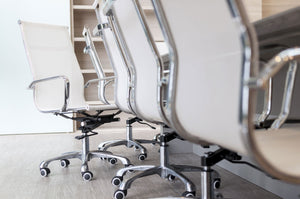The state of office furniture is not just a matter of aesthetics; it plays a crucial role in employee productivity, health, and overall well-being. So, how do you know when it's time to update or swap out desks, chairs, and other office staples? Here are some key indicators.
Signs of Wear and Tear
The most obvious reason to replace office furniture is visible signs of wear and tear. Stains, broken wheels, unstable legs, or frayed upholstery not only look unprofessional but could also pose a safety hazard. If your furniture is showing its age in a way that could lead to accidents or injuries, it’s time to consider new options.
Ergonomic Concerns
Office furniture has come a long way in terms of ergonomic design, aimed at minimizing strain and promoting healthier postures. If your furniture is not ergonomically designed, it could contribute to employee discomfort or health issues. This may result in increased sick days or decreased productivity. Upgrading to furniture that offers better lumbar support, height adjustability, and proper alignment can make a big difference.
Outdated Style
While functionality is crucial, style does matter. Outdated furniture can give the wrong impression to clients and visitors, potentially affecting your company’s image. Moreover, a modern, well-designed workspace can boost employee morale and productivity.
Office Reconfiguration
Redesigning or expanding your workspace is an ideal time to evaluate your furniture needs. If your current setup doesn't align with the new design, or if you're moving to an open-plan office that requires more collaborative furniture, use this as an opportunity to update.
Technological Advances
The rapid advancements in technology also extend to office furniture. Many modern designs incorporate features for better cable management, more accessible power outlets, and built-in docking stations. If your current furniture makes it difficult to integrate technology seamlessly, it may be time for an upgrade.
Budget and Investment
It’s important to look at furniture as a long-term investment. While high-quality, ergonomic furniture can be expensive, the long-term benefits often outweigh the initial costs. Budget accordingly to ensure you can afford pieces that will last and provide the benefits you're looking for.
How Often Should You Replace Office Furniture?
There’s no set timetable for when to replace office furniture, as it varies depending on the type and quality of the furniture, as well as its usage. However, a general guideline is:
- Office chairs: 7-10 years
- Desks: 10-15 years
- Filing cabinets: 10-20 years
- Reception furniture: 5-10 years
Factors like warranty, build quality, and the intensity of use should also be considered.
Final Thoughts
Deciding when to replace office furniture is a nuanced decision that involves considering the condition, ergonomic design, style, and functionality of your current setup. Take into account both the immediate and long-term benefits of new furniture, and use these guidelines to help you make an informed decision.

